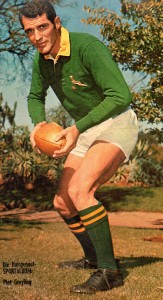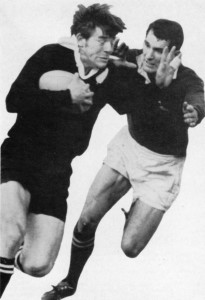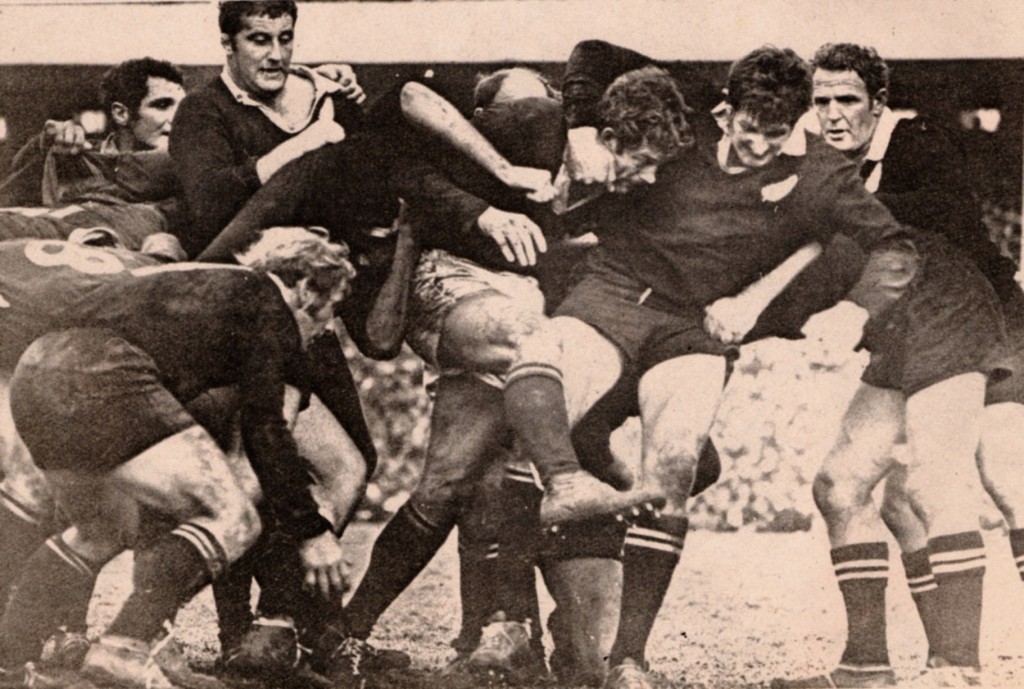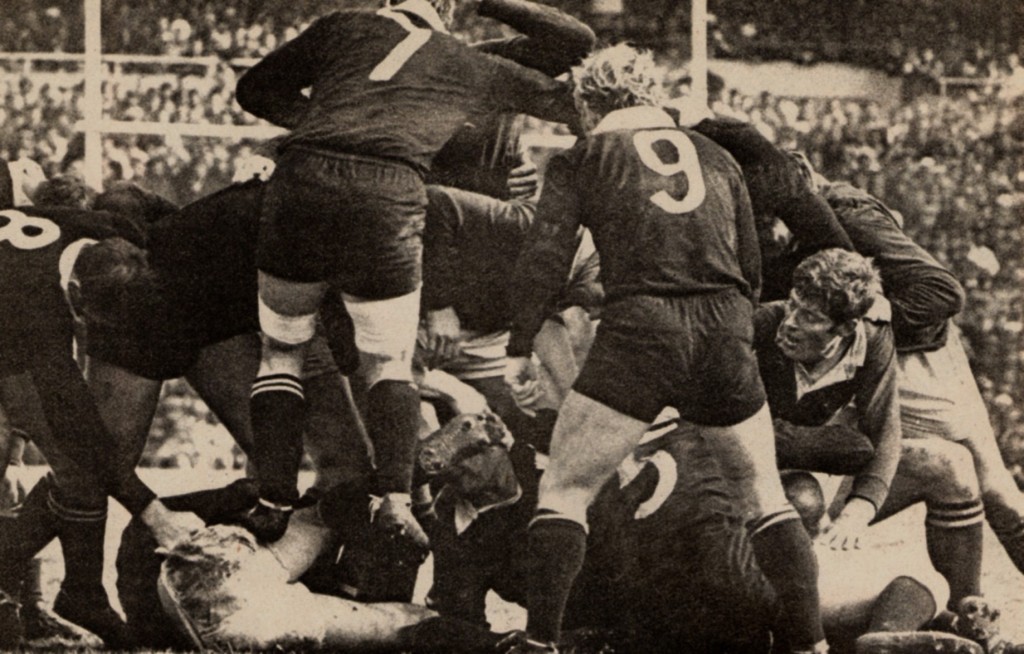
 After my tribute to Jan Ellis I thought I just have to write something about the man who was a big part of Jan’s success as a Springbok rugby player, Piet Greyling.
After my tribute to Jan Ellis I thought I just have to write something about the man who was a big part of Jan’s success as a Springbok rugby player, Piet Greyling.
Currie Cup-winning Transvaal captain in 1971 and 1972, former Springbok flanker Piet Greyling, was arguably one of the best, but certainly one of the toughest.
The picture below shows Piet Greyling with his Transvaal side who got a share of the Currie Cup for the first time in 19 years – having previously won it in 1952 – when they shared the cup with Northern Transvaal in an epic final and controversial 14-14 draw at Ellis Park in 1971. The next year Greyling led his Transvaal side to a 25-19 win over Eastern Transvaal at Pam Brink Stadium in Springs to win the cup with the help of Gerald Bosch who dropped the winning points in the final minutes. It was back in 1972, before the Currie Cup final against Eastern Transvaal in Springs that the former Bok captain uttered these famous words to his Transvaal team-mates: “Eighty minutes of agony for an eternity of pleasure.”

The team that shared the cup in 1971 ( From left to right). BACK: Theo Sauermann, Tommy Symons, Jannie van Aswegen, Kevin de Klerk, Simon Norwood, Anton Oberholzer, Gert Schutte and Johan van Wyngaardt. MIDDLE: Tobias du Toit, Martiens Louw, Mr Jannie le Roux (President of Transvaal rugby), Piet Greyling (Captain), Mickey Gerber (Coach), Jannie van Deventer and Robbie Barnard. FRONT: Piet Cronje and Jannie Barnard.
Greyling was only 30 at the time, but after 25 Tests in the Springbok jersey, with the last ending in defeat in his only Test as skipper against England in Springs, losing 18-9, he called it a day.

Piet Greyling captained the Springbok team the first against a provincial team in Orange Australia during the 1971 tour. Here he leads the team on the field.
The late Dr Danie Craven had this to say about Greyling: “Piet always had a smile on his face. During his playing days that smile proved his enjoyment of the battle and the fact that he never seemed to lose, it shows how much he enjoyed his rugby. His smile meant to me that Piet was full of confidence and that he was loving every minute of the action because he was playing well: that was patently obvious. Piet Greyling was and is destined to excel in whatever his endeavour. A wonderful flanker, he was always first to the loose ball and when he got there he always knew what to do with it.”
Piet Greyling is mostly remembered for this partnership with Jan Ellis. Ellis and Greyling become a partnership in1967 playing in the first test of that series against France. First test matches in a series are crucial but this one was of particular critical importance as the Springbok team was staggering against the ropes after having lost 8 out of their last 9 test matches since 1965. ‘This is arguably the most important test match in the history of Springbok rugby’, said Danie Craven before the match. The South Africa preparation and build-up for this series was therefore pretty intense and the team selection process unusually resolute. Losing the test match/series due to selection errors was not a mistake the wise men of South Africa wanted make after the black year of 1965. The dogged determination that sprang forth from the selector’s motivation to get it right almost robbed South African rugby from almost certainly the best flanker combination in its long history.
The problem was that Ellis –who made a name for himself on the 1965 tour to New Zealand – was struggling with an ankle injury and after having declined invitation to the first three trail matches was not even invited to the last trail match. Greyling on the other hand having made a name from himself during the domestic season in 1966 and 1967 had such a poor show during the first trial match due to a recurrent episode of Bilharzia that he was reportedly been written-off by the selectors.
The Maritzburg Collegians Club however invited Ellis to play in curtain-raiser to the final trails against Durban Collegians. It was this gesture of foresight that ensured the selection of Ellis for this test match as El Try Hombre (so called by the Beunos Aires newspapers when he scored 18 tries for the Gazelles touring through South America) scored a couple of tries for Maritzburg and did enough to satisfy the selectors that he was fit enough and over his ankle injury. Greyling also played well enough in the trails match to ensure selection and to see the birth of the formidable Ellis/Greyling flank forward combination.
It was in this first test of 1967 series that the idea of ‘fetcher’ and playmaker became part of the South African psyche. Ellis and Greyling writes Maxwell Price was glued together; always contrived to the ball with superb hunting and aggressive play at the tackle ball. Their sufficiency in linking, hunting and securing either turnover ball or protecting possession was instrumental in South Africa establishing a 23-3 lead after five minutes in the second half with Greyling scoring twice and Ellis once.

Piet Greyling shown here playing against the French of 1967.
Ellis injured his shoulder at the start of the 1969/70 EOYT to the UK and eventually played in only 4 of the first 17 matches. JBG Thomas writes that this injury to Ellis was a key contributing factor (as well as Visagie’s drop in form) to South Africa poor tour results. At the end Ellis made 10 appearances on tour scoring 8 tries but his injury was a major blow to the team as his partnership with Greyling was a big part of the team tactical approach. Greyling walked away from the 69/70 tour as one of the three most consistent forwards (the others being Hannes Marais and Tommy Bedford) on the tour. JBG Thomas in his book ‘Springbok invasion’ writes the following about Greyling: One of the outstanding forwards of the party Piet Greyling was a tireless, experienced and intelligent flanker, who excelled in attack and defence. Tall, lean and strong, he possesses considerable speed and sure hands and good positioning sense. As one would expect from a test pair of several seasons, Greyling appeared to work better when Ellis was in harness with him, and when Bedford was directing the pack from the No. 8 position.

Piet Greyling scoring against Ireland in 1969.

The photo is of Greyling playing in New Zealand in an early-season charity match in 1972 in Christchurch (the stands in the background are Lancaster Park, and the opposition No. 11 is wearing Canterbury colours). It is a perfect example of body position, watching your opponent, and cradling of the ball in the correct hand ready to fend off the defender with the other in anticipation of the impending collision. A superior craftsman at work!

This picture shows Greyling making a try saving tackle during the first test of the 1971 tour to Australia.
After making his debut in the French series of 1967 where he scored two tries in the opening international and played in all four Tests, he was injured in the first Test of the 1968 series against the British Lions.
They were the only Tests he missed in his Test career, but it was Greyling’s robustness that impressed British Lions pivot Barry John in his autobiography.
“These two were talented flankers – Greyling and Ellis. Greyling was the destructive one causing chaos and Ellis was the constructive partner who set up moves and capitalised on the chaos that Greyling caused.”
In 1970 he was trampled by the All Blacks, suffering a cracked rib and was in severe pain. He had to receive medical treatment, but he never allowed the All Blacks to know how severely he was injured (see picture below).

This picture shows Piet Greyling waiting for treatment after being trampled in the loose by the All Blacks to the extent that one of his ribs fractured. He kept on playing.
In The Chosen: The 50 Greatest Springboks of all Time it quoted the biography of former All Black legend Colin Meads: “South Africa’s Piet Greyling and Jan Ellis in 1970 exposed the myth that New Zealand loose forwards were still the quickest in the world to the loose ball. And when they got there these two, and Greyling especially, were constructive.”
In 1970 the All Blacks got beaten at the breakdown and consequently in the series due to the untiring and relentless work rate of the Ellis and Greyling in the tight loose. They so frustrated the All Blacks that Greyling and Ellis were given ‘special treatment’ at the breakdowns as can be seen in the pictures below.
These pictures taken in the second test of the 1970 series tells in essence the story of the series. A couple of things stand out, for me, in these photographic images of that series. Notice in the first instance that all three the Springbok loose forwards appear in all four pictures; Ellis and Greyling were glued together. Notice in the second instance the low body positions of the three South African loose forwards; they are low and driving through the ball while the New Zealand players are going backwards. Thirdly notice that it’s the New Zealand players who are playing the man while the South African loosies are more focused on playing the ball and going forward.

In this picture Alan Sutherland has Ellis in a headlock while Ellis is driving through the ruck. Notice Greyling in the background joining the ruck eye on the ball but in a low body position. Notice also the low forward driving position of Albie Bates (No8) between Ellis and Greyling.

In this picture Alex Wylie (All Black No7) is stamping on Albie Bates lying on the ground. Jan Ellis is on the right of the picture in a low but head-up position. Piet Greyling can be seen just behind Ellis and Chris Laidlaw (All Black No9). Wylie is stamping on Bates because he arrived too late and to upright so all he can do is to stamp on players who arrived first and who has their hands on the ball.

These next two pictures show Alex Wylie’s increasing frustration with the hard as nails Piet Greyling (who as far as I know never punched anyone in a test match). In the top picture Wylie’s got Greyling face in his one hand while preparing to punch him; notice Greyling is moving forwards. Shortly after that Wylie actually punched Greyling and the bottom picture shows Albie Bates seizing the arm of a surprised Greyling to prevent him from falling. Again both Ellis and Bates can be seen in close proximity to each other and to Greyling in these two pictures.

Piet exerted extreme pressure on halfback Chris Laidlaw during that 1970 series as the pictures below reveal.
The first Springbok try in that series came about after Greyling kicked a ball through from a scrum. That incident is shown in this photo.


This picture shows Piet tackling Laidlaw behind the scrum.
Greyling only made it big when he was sent from his father’s tobacco farm in the-then Rhodesia to attend school in Bloemfontein at 14.
He attended Sentraal High School and made the Free State schools team but after matric he went to Potchefstroom Agriculture College to briefly study agriculture before returning to Mashonaland.
In provincial rugby terms Piet is remembered as having been the captain of Transvaal but he started his career playing for Rhodesia and Free State and then for Northern Transvaal before moving to Transvaal.
He went back to Bloemfontein in 1967 to work as a sales rep for a brewer and his chance came against the French. In all of his 25 Tests, he played only one without Jan Ellis on the other side.
His test statistics can be seen by clicking on this link.
Jan Ellis and Piet Greyling were the real deal and Piet probably never received the credit he deserved for that fabulous 1970 victory over Brain Lochore outstanding All Black team.
GBS, this one is for you.
In ,67 i was just a fanatical Springbok supporter, my dad listened on the radio, Gerhard Viviers was the best, and for me every Springbok a hero. I wish one can get access to the Rugby commentary of Gerhard and Charles Fortune.
Ellis and Greyling was indeed very good and to put it like Gerhard would i would include Pragtig, Briljant, Manjefiek esovoorts.
Hierdie Cip is vir my gespoil met al die byklanke , maar die beeld materiaal is briljant
Gerhard
Hulle se een swaeltjie maak nie somer nie maar damm Joost was n vonk in Springbok rugby. Ek soek bietjie op You Tube na Gerhard Viviers se kommentaar en kom toe op hierdie tribute af, al het ek dit n duisend maal al gekyk sal ek weer en weer. Joost was absoluut briljant , manjefiek……
/pulling chair closer with pop corn.
Mclook how about doing one of the Western Province team of the 80’s. You can leave out the part where Freestate breaks Kalla Scholtz legs though
McLook,
Marvelous!
Thanks a million… I really appreciate this one!
@ Bliksem:
I have some stuff on the 1980 CC final and the game they played against the Britsh and Irish Lions so I’ll have a look at it. Maybe I’ll be able to conjure something.
Users Online
Total 39 users including 0 member, 39 guests, 0 bot online
Most users ever online were 3735, on 31 August 2022 @ 6:23 pm
No Counter as from 31 October 2009: 39,395,966 Page Impressions
_